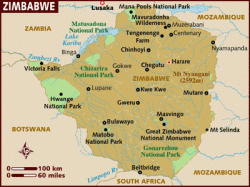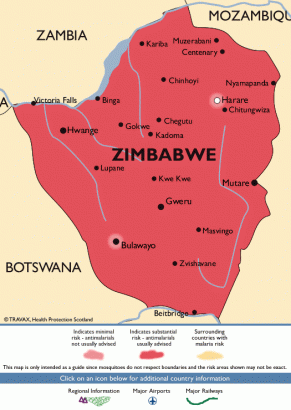Geography of Zimbabwe

Zimbabwe is located in Southern Africa between South Africa and Zambia (“Zimbabwe” 2). It is mostly high plateau with higher central plateau and mountains in the east. The lowest point in Zimbabwe is at the junction of the Runde and Save rivers where it is 162m. The highest point is Mt. Inyangani which is 2592m high(“Zimbabwe” 2). Zimbabwe has two main rivers: the Limpopo in the south and the Zambezi in the north (Sheehan 9). The Zambezi flows for 1650 miles (2655km). It contains the very famous, Victoria Falls. Lake Kariba is an artificial lake covering 2000 square miles (5180 square km) (Sheehan 9). The Limpopo is about 1100 miles (1770 km) long and flows north from South Africa (Sheehan 10). Zimbabwe has many more rivers and lakes but these are just a few.
The geography of Zimbabwe helps spread the disease. Malaria is caused by plasmodia found in mosquitoes (“Malaria” 95&96). Normally, mosquitoes breed near or in water. Because Zimbabwe has many rivers mosquitoes are found in many places. Unfortunately, there is nothing we can do about the rivers so we have to find other ways to get rid of the mosquitoes (See Conclusion link).
Government of Zimbabwe
Zimbabwe is a constitutional democracy, with declaration rights that guarantees the freedom of the person, regardless of their race, religion or gender (Sheehan 37). An executive president, which is elected by the people to a six year term in office, heads the government (“Zimbabwe” 592). Once the president is selected he then appoints two vice presidents and a Cabinet to carry out the government’s operations (“Zimbabwe” 592). There is a House of Assembly, which has 150 members, and a Senate, which has 66 members(“Zimbabwe” 592). In the House of Assembly, 120 members are elected by the people, 12 are appointed by the president, 8 are provincial governors, and 10 are traditional chiefs(“Zimbabwe” 592). In the Senate, 50 members are elected, 6 are appointed, and 10 are traditional chiefs (“Zimbabwe” 592). Both the house and the Senate serve a five year term (“Zimbabwe” 592).
Right now the government of Zimbabwe and the United States are spending about 1.5 billion USD (U.S. dollars) on malaria ("Funding for Malaria Today"). The government is helping prevent malaria. However, Zimbabwe is very poor, so when the government has to increase funds, it leaves less money for other important things like food.
People and Culture of Zimbabwe
Twelve million people live in Zimbabwe, 32% of whom live in urban areas and 45% who are younger than 15 years ("Socioeconomic Overview: Zimbabwe" ). Seven out of ten Zimbabweans work in the countryside (Sheehan 57). There are several ethnic groups, African, mixed, Asians and white people ("Zimbabwe- People"). They speak English, Shona, Sindebele, and numerous but minor tribal dialects ("Zimbabwe- People"). Some religions found in Zimbabwe are Syncretic, Christianity, indigenous belies, Hinduism and Muslim (“Zimbabwe- People”). 25% of Zimbabweans are members of Christian churches and that percent is slowly increasing (Sheehan 73). Most Zimbabweans are Shona (or Mashona) people (Adams et al. 250). Did you know that to marry, a man has to pay the father for the bride (Sheehan 63)? Did you know that Zimbabweans blame their troubles on witches (Sheehan 78)? So how could all this culture effect malaria in Zimbabwe?
As I said before, most Zimbabweans live in the countryside. They believe that the creator god is Mwari (Sheehan 73). I think that they live in the countryside because that is where they can worship and make a living. Also they are one of the poorest countries in Africa. This all leads to not having enough money in the nonurban areas to buy bed nets and medicine. They stay in the country because that is where they can farm, but they are unaware of the seriousness of this situation.
In the picture above you see the parts of Zimbabwe affected by malaria. The red represents substantial risks. The tan represents surrounding countries with malarial risk. The pink represents minimal risk. As you can see almost all of Zimbabwe is at risk. There are only two spots that are pink, Harare and Bulawayo. You may notice that they are not located near rivers. Because of this they are at minimal risk of malaria.

